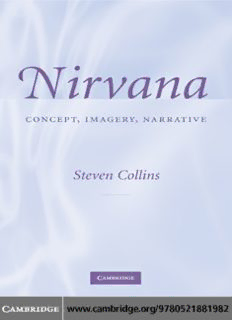
Nirvana: Concept, Imagery, Narrative PDF
Preview Nirvana: Concept, Imagery, Narrative
This page intentionally left blank nirvana: concept, imagery, narrative The idea of nirvana (Pali: nibba¯na) is alluring but elusive for non- specialists and specialists alike. Offering his own interpretation of key texts, Steven Collins explains the idea in a new, accessible way – as a concept, as an image (metaphor) and as an element in the process of narratingbothlinearandcyclicaltime.Exploringnirvanafromliterary and philosophical perspectives, he argues that it has a specific role: to provide‘thesenseofanending’inboththesystematicandthenarrative thought of the Pali imaginaire. Translations from a number of texts, includingsomedealingwithpastandfutureBuddhas,enablethereader toaccesssourcematerialdirectly.Thisbookwillbeessentialreadingfor students of Buddhism, but will also have much to teach anyone con- cernedwithAsiaanditsreligions,orindeedanyonewithaninterestin theideasofeternallifeortimelessness. STEVENCOLLINSisChesterD.TrippProfessorintheHumanitiesatthe UniversityofChicago.HeistheauthorofNirvanaandOtherBuddhist Felicities:UtopiasofthePaliImaginaire(Cambridge,1998). NIRVANA Concept, Imagery, Narrative STEVEN COLLINS CAMBRIDGEUNIVERSITYPRESS Cambridge, New York, Melbourne, Madrid, Cape Town, Singapore, São Paulo, Delhi, Dubai, Tokyo Cambridge University Press The Edinburgh Building, Cambridge CB2 8RU, UK Published in the United States of America by Cambridge University Press, New York www.cambridge.org Information on this title: www.cambridge.org/9780521881982 © Steven Collins 2010 This publication is in copyright. Subject to statutory exception and to the provision of relevant collective licensing agreements, no reproduction of any part may take place without the written permission of Cambridge University Press. First published in print format 2010 ISBN-13 978-0-511-67762-5 eBook (NetLibrary) ISBN-13 978-0-521-88198-2 Hardback ISBN-13 978-0-521-70834-0 Paperback Cambridge University Press has no responsibility for the persistence or accuracy of urls for external or third-party internet websites referred to in this publication, and does not guarantee that any content on such websites is, or will remain, accurate or appropriate. Contents Introduction page 1 1 Whatisthisbook,andwhoisitfor? 3 Thediscourseoffelicity:imagininghappiness 4 ThePaliimaginaire 7 Eu-topiaandou-topia 8 Notesonthewords‘Therava¯da’and‘religion’ 1 Systematicandnarrativethought:eternityandclosurein structureandstory 12 16 Closureinsystematicthought 19 Closureinnarrativethought 2 Nirvanaasaconcept 29 29 Action,conditioning,time,andtimelessness 39 Nirvanainlifeandafterdeath 47 Nirvanaexists 55 Canonedesirenirvana? 58 Silenceandtheproductionofmeaning 3 Nirvanaasanimage 61 Thewords(pari)nirva¯naand(pari)nibba¯na;otherreferringterms ˙ 63 anddefinitedescriptions 69 Twoaporias:consciousnessandhappiness 78 Imageryandexpressibility 94 Appendix:happinessinmeditation 4 Nirvana,time,andnarrative 100 100 Themythof‘theMythoftheEternalReturn’ Individualversuscollectivetime:canhistoryend?WasGotama 105 unique? 110 Thesenseofanending v vi Contents 112 Ending(s)innarratedtime(erza¨hlteZeit)1:non-repetitivetime 114 Ending(s)innarratedtime(erza¨hlteZeit)2:repetitivetime 122 Endingasaneventinthetimeofnarration(Erza¨hlzeit) 5 PastandfutureBuddhas 126 136 Vamsaasagenre ˙ VoiceandtemporalperspectiveintheChronicleofBuddhas: 139 repetitiveandnon-repetitivetimeinterwoven TheStoryoftheElderMa¯leyyaandTheHistoryoftheFuture: 148 unprecedentedwell-being Appendix1:SelectionsfromtheBuddhavamsa 153 Appendix2:TheAna¯gatavamsa ˙ 172 ˙ Conclusion:modesofthought,modesoftradition 185 Notes 189 Index 194 Introduction what is this book, and who is it for? This book is a rewritten version of Part I in my Nirvana and Other Buddhist Felicities, published by Cambridge University Press in 1998(paperback2006).Thatbookislong,complex,expensive,and noteasytouseinteaching.InthisbookIaimtotaketheattemptat understanding nirvana offered in the earlier one, and present it in whatIhopeisamoreaccessibleform;themaintextislesscrowded with details, all direct references to Pali texts have been removed, and most references to secondary works have been placed in the endnotes. All translations are my own. Although it is intended for that mythical beast, the General Reader, I have had primarily in mind university classes, at either the undergraduate or graduate level, in courses on Buddhism, comparative Religious Studies, History, Anthropology, or other. It is intended to provoke discus- sion rather than to present unalterable conclusions. In my experi- ence with students at the University of Chicago to whom I have taughtwhatispresentedhere,theoverallmethods,arguments,and conclusions are quite comprehensible, when explained pedagogi- cally,whetherornotindividualshappentobepersuaded.Readers, and teachers using the book in classes, might consult the longer bookformoredetail,andfortheoverallargumentaboutnirvanaas apartofwhatIcalltherethediscourseoffelicity(explainedbriefly 1 2 nirvana: concept, imagery, narrative below),andas partofwhat thesubtitle ofthat bookcalled Utopias of the Pali Imaginaire. But this is by no means necessary. To suggest in what vein I would like this book to be read, or at least one of them, I would point to a body of work on the early Christian and medieval European worlds produced by Caroline Walker Bynum, collected in the volumes entitled Fragmentation and Redemption (1991), The Resurrection of the Body in Western Christianity, 200–1336 (1995), and Metamorphosis and Identity, (2001).1 Bynum achieves a combination of two things, inter alia, whichitwouldbepresumptuousofmetoclaimalso,althoughIcan atleastsaythat itis myaspiration: shedeals with fundamental and timelessexistentialissues–thenatureofembodiment,itsrelationto death and the possibility of life thereafter, the conceivability of eternal life, and much else besides – but in a manner which exemplifies the intellectual and academic virtues, again inter alia, of detailed linguistic (and other) analysis, meticulous care, and lucid exposition, in reading and discussing texts produced in an historicalperiodquitedifferentfromourown.Whatispresentedin this book, from the Pali imaginaire, was produced in roughly the samehistoricalperiodsasthetextsdealtwithinBynum’swork,and it responds to many of the same timeless issues, but in an overall ideology different from the Christian in some very fundamental ways(thoughonecouldalsoargue,perhaps,thatasacivilizational ideologyinprescientificpremodernity,itisthesame,orsimilar,in some equally fundamental ways; that is one thing readers might discuss). What I have to say about what I will call systematic and narrative thought, and about the philosophical and cultural- historical importance of imagery and metaphor, and their capacity to be a connecting bridge between systematic and narrative thought, might also be thought through in relation to other tradi- tions (and here Bynum’s work will also be helpful). But that is an
Description: